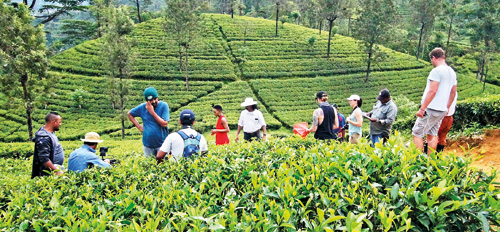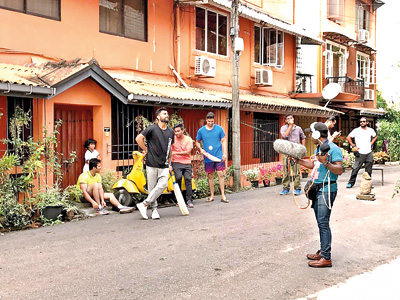News
Govt. turns blind eye to power of cinema tourism

Film crew in the hills
It would take only a few simple steps to turn Sri Lanka into a global film destination. The result would be jobs, technology and knowledge transfer, as well as millions of dollars in revenue. But the Government isn’t having it.
For years, industry leaders have canvassed politicians to introduce incentives and to actively promote Sri Lanka to foreign film production companies. Once the war ended, the future seemed promising. So they formed the International Film Producers Association (FPA). They even drafted proposals and presented them on a platter to policy and decision makers.
In 2016, Prime Minister Ranil Wickremesinghe appointed a committee to make recommendations. Among its members were renowned filmmakers Chandran Rutnam and Prasanna Vithanage. They proposed a 30 percent tax rebate for foreign companies wishing to make films in Sri Lanka. The benefit would be granted after an audit of their bills.
“It must be in the Prime Minister’s cupboard,” Mr Vithanage said of their report, this week. It contained many other proposals but there was no progress beyond verbal undertakings.
Sandya Salgado, Director and Business Strategist at the production company Film Island, is on a team leading the campaign to promote filmmaking and film tourism in Sri Lanka. After months of futile attempts, the frustration is showing.
The production of foreign films earned the country around US$15mn last year. “We can multiply it hundredfold if we just have our house in order,” Mrs Salgado said. But the authorities are impervious to entreaties. Only the Sri Lanka Tourist Promotion Bureau (SLTPB) has grasped the potential and offered assistance. Neither the National Film Corporation (NFC) nor the Ministry of Culture showed interest.
“Cinema tourism is a lucrative proposition the country should take serious note of,” she said. “It is about marketing Sri Lanka, it is about nation branding and about positioning us as a potential shooting destination. Look at mileage New Zealand suddenly got after Lord of the Rings.”
There’s no gainsaying that Sri Lanka is an ideal location. The weather is fair and various landscapes can be reached within a few hours of travel on what is an increasingly good road network.
“In India, if you want to go to a good location, you often have to fly or take a very long trip,” Mr Rutnam said. “They also have different States with their own sets of rules and regulations. We don’t have that. We don’t have as much red tape and we have people with good technical knowledge who’ve worked on international pictures.”
Mrs Salgado thinks, however, that everything must be further simplified to reduce time-wasting for filmmakers. Ideally, it should be the NFC or equivalent body that must take leadership of making this endeavour worthwhile for the country. Policies and processes have to come into place to position and package the country as a viable destination. None of that is being done.
“Cinema comes under one Minister,” she said. “The National Film Corporation comes under another Minister. The Tourist Board comes under another Minister. It’s like it is nobody’s business. As a result, nobody cares. But this is clean money, dollars. And there are peripheral services that also benefit.”
Some of these are the hotel, transport and travel industry. There are local sectors like art people, designers, equipment providers, food suppliers and so on. And knowledge exchange includes new techniques in filmmaking and marketing.
But, politically, “nobody seems to care or understand”. Harsha de Silva, when he was Deputy Minister for Foreign Affairs, took a brief interest resulting in the SLTPB getting involved through his intervention. Since then the industry has struggled to get even their budget proposals introduced.
They cannot do this on their own. “Even if we ram our heads on the wall and encourage filmmakers to come to Sri Lanka, we, as a group of individuals can’t do much because they have expectations. The systems and processes are not in place here.”
Among these expectations are incentives and rebates. For instance, Malaysia offers a 30 percent tax rebate known as the ‘Film in Malaysia Incentive’ provided foreign companies undertaking feature production spend a minimum of US$1.6mn; and television series spend a minimum of approximately US$125,000 per broadcast hour. At least 30 percent of the production crew must be Malaysian and they must take on a minimum number of interns who will gain training and experience.
“We are not giving anything,” Mrs Salgado said. “We don’t have to give rebates in cash as other countries do, if our economy is not doing well. We can give so much in kind. For instance, if a big crew of 150 is coming, we could waive visa fees. Colossal amounts are paid to various locations. Discounts could be offered for these. And I’m speaking of massive film productions.”
The local companies do what they can. For instance, Mrs Salgado’s company is negotiating with a famous Indian filmmaker and is hopeful that more business from South Asia will follow if they seal the deal. At the moment, Indian producers are flocking in numbers to Fiji.
“Bollywood is across the Palk Strait,” she said. “They are spending billions on film. Just a fraction of that would make our lives so much better.”
Mr Rutnam, who has seen it all, is still fighting the good fight – even though “in the last 50 years, we have never ever promoted ourselves properly”. “We do not know what we’re doing,” he asserted. “We’re not making use of iconic assets and situations that we have.”
‘Bridge on the River Kwai’ was one of the greatest pictures ever made and it was filmed in Kitulgala. “What do we show people for it?” Mr Rutnam asked. “We show them holes in a rock and say that’s where the film was made! We should have built the bridge!”
This would have spawned various businesses around it, he said. That is how film sets become tourist destinations. There is also nothing to see at the sites where ‘Indiana Jones and the Temple of Doom’ was filmed. Mr Rutnam worked on that movie with Steven Spielberg.
“Don’t these people understand the power of cinema?” he asked. And answered it himself: “They don’t.”
Priyanga T Kumarasinghe is the owner of Crew for Shoots and FPA President. He urges the Government to introduce a streamlined method and system of foreign filmmaking in Sri Lanka. Such a move would also circumvent the type of confusion that occurred in Kandy recently when two overseas participants of a Belgian TV production were accused of participating in a gay marriage in traditional Sri Lankan attire.
Mr Kumarasinghe’s company has handled multiple commercials productions in Sri Lanka. And he sees interesting opportunities. “For example, we are currently doing a commercial for Pakistan, but the entire team, including models, director, producer, everybody is from India,” he said. “Even though relations between the two nations are fraught, citizens are good friends.”
“Pakistanis are not allowed to go to India to film, and Indians are not allowed to go to Pakistan to film,” he continued. “Most Pakistani advertisements are done by Indians. If we catch this particular Asian market alone, our economy will be so much better.”
“You don’t have to look far,” Mr Kumarasinghe reiterated. India’s advertising and film industry is the largest in the world. But, like Sri Lankans, they like incentives and discounts. If the Government floats an acceptable policy, this market share could be exploited effectively.
Like the others, Mr Vithanage espoused a central body with one-window to get permission. He also called for guidelines. The benefits will be immense if the Government grabs the opportunity. When that will happen, however, is anybody’s guess.

Virat Kohli shooting a commercial in Sri Lanka

